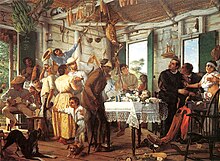| |
|---|---|
 Afro–Puerto Rican women in Bomba dance wear | |
| Total population | |
| 228,711-1,000,000[1][2] (Includes Afro-Puerto Ricans living outside of Puerto Rico) | |
| Regions with significant populations | |
| Puerto Rico (more heavily concentrated in coastal Northeast regions of the island) | |
| Languages | |
| Religion | |
| Predominantly Catholicism; Protestantism; Rastafari and other Afro-diasporic religion (mainly Santería) | |
| Related ethnic groups | |
| Yoruba people, Arará, Fang people, Bubi people, Afro-Cubans, Afro-Dominicans, Afro-Haitians, other Afro-Latin American and Afro-Caribbean ethnic groups |
| Part of a series on |
| Forced labour and slavery |
|---|
 |
| Part of a series on |
| Puerto Ricans |
|---|
 |
| By region or country |
| Subgroups |
| Culture |
| Religion |
| History |
| Language |
|
|
Afro-Puerto Ricans (Spanish: Afropuertorriqueños), most commonly known as Afroboricuas, but also occasionally referred to as Afroborinqueños, Afroborincanos,[a][3] or Afropuertorros,[b][4] are Puerto Ricans of full or mostly sub-Saharan African origin, who are predominately the descendants of slaves, freedmen, and free Blacks original to West and Central Africa.[5][6] The term Afro-Puerto Rican is also used to refer to historical or cultural elements in Puerto Rican society associated with this community, including music, language, cuisine, art, and religion.
The history of Afro-Puerto Ricans traces its origins to the arrival of free West African Black men, or libertos (freedmen), who accompanied Spanish Conquistador Juan Ponce de León at the start of the colonization of the island of Puerto Rico.[7] Upon landing and settling, the Spaniards enslaved and exploited the indigenous Taíno natives to work in the extraction of gold. When the Taíno forced laborers were exterminated primarily due to Old World infectious diseases, the Spanish Crown began to rely on sub-Saharan African slavery emanating from different ethnic groups within West and Central Africa to staff their mining, plantations, and constructions.[8][9]
While there was slavery in Puerto Rico, the island receive less sub-Saharan enslaved laborers than other Spanish and non-Hispanic colonies in the Caribbean and the Americas. The need for direct enslaved labor brought through the Atlantic slave trade, was greatly reduced by the depletion of gold in Puerto Rico in the 16th century, and the island began to serve primarily as a strategic and military outpost to support, protect, and defend trade routes of Spanish ships traveling between Spain and territories within the continental Americas. However, the Spanish, hoping to destabilize the neighboring colonies of competing world powers, encouraged enslaved fugitives and free people of color from the non-Hispanic Caribbean to emigrate to Puerto Rico. As a result, Puerto Rico indirectly received large numbers of sub-Saharan Africans from neighboring British, Danish, Dutch, and French colonies seeking freedom and refuge from slavery.[10]
In the 19th century, slavery in Puerto Rico was increased, as the Spanish, facing economic decline with the loss of all of its colonial territories in the Americas aside from Cuba and Puerto Rico, established and expanded sugar cane production in the island. Since 1789, slaves in Puerto Rico were allowed to earn or buy their freedom. Throughout the years, there were several slave revolts in the island. Promised their freedom, slaves participated in the 1868 Grito de Lares revolt against Spanish rule. On March 22, 1873, slavery was officially abolished in Puerto Rico.
The contributions of Puerto Ricans of full or mostly sub-Saharan African descent to music, art, language, and heritage have been instrumental in shaping the culture of Puerto Rico.
- ^ "Puerto Rico". United States Census Bureau. Retrieved February 24, 2024.|access-date=2023-04-01
- ^ "Puerto Rico 2020 census". Archived from the original on 2020-02-14. Retrieved 2021-09-27.
- ^ "puertorriqueño". Diccionario de la Lengua Española por la Real Academia Española (in Spanish). Retrieved January 19, 2024.
- ^ "puertorro". Asociación de Academias de la Lengua Española: Diccionario de Americanismos (in Spanish). Retrieved 2024-01-19.
- ^ "Puerto Rico 2020 census". Archived from the original on 2020-02-14. Retrieved 2021-09-27.
- ^ Via, Marc; Gignoux, Christopher R.; Roth, Lindsey A.; Fejerman, Laura; Galanter, Joshua; Choudhry, Shweta; Toro-Labrador, Gladys; Viera-Vera, Jorge; Oleksyk, Taras K.; Beckman, Kenneth; Ziv, Elad; Risch, Neil; Burchard, Esteban González; Martínez-Cruzado, Juan Carlos (31 January 2011). "History Shaped the Geographic Distribution of Genomic Admixture on the Island of Puerto Rico". PLOS ONE. 6 (1): e16513. Bibcode:2011PLoSO...616513V. doi:10.1371/journal.pone.0016513. PMC 3031579. PMID 21304981.
- ^ "Afro-Puerto Rican". Afropedia.org. Archived from the original on November 28, 2020. Retrieved March 23, 2016.
- ^ "Afro-Puerto Ricans in Puerto Rico". Human Rights Group. Retrieved February 24, 2023.
- ^ "San Mateo de Cangrejos: Comunidad Cimarrona en Puerto Rico" (PDF). Gilberto Aponte Torres (in Spanish). Retrieved February 24, 2023.
- ^ "Race, Colonial Exploitation and West Indian Immigration in Nineteenth-Century Puerto Rico, 1800-1850". JStore. Retrieved February 24, 2023.
Cite error: There are <ref group=lower-alpha> tags or {{efn}} templates on this page, but the references will not show without a {{reflist|group=lower-alpha}} template or {{notelist}} template (see the help page).
© MMXXIII Rich X Search. We shall prevail. All rights reserved. Rich X Search
